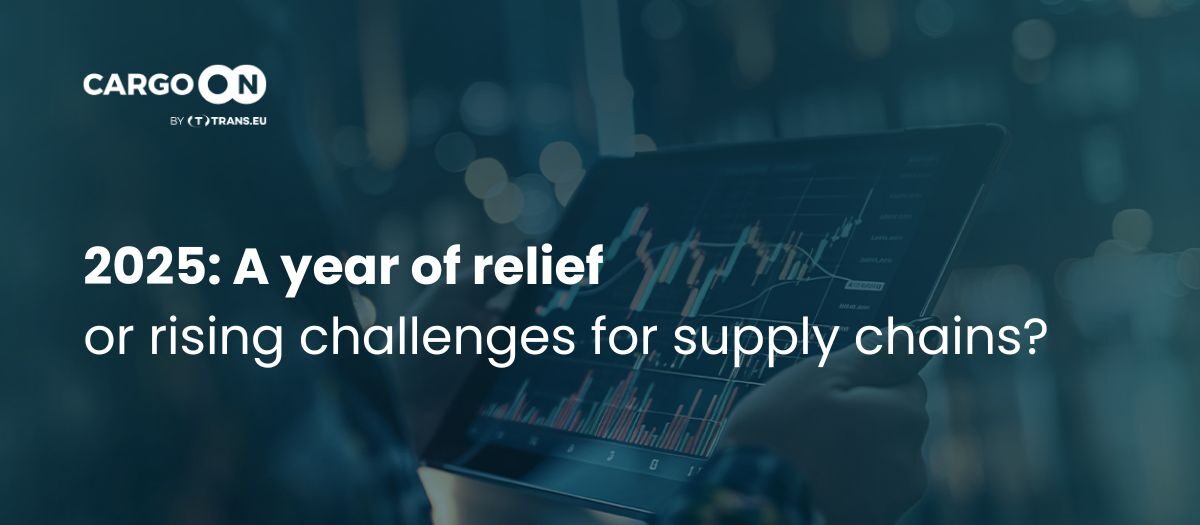Market Insights ON 2025: Key trends reshaping European logistics and transport

The latest edition of Market Insights ON presents a comprehensive analysis of the factors shaping logistics and transport in 2025. This report delves into economic trends, freight market fluctuations, digitalization advances, and regulatory shifts that will impact supply chains across Europe. With contributions from industry experts, it highlights both challenges and opportunities, providing valuable insights for supply chain managers, logistics professionals, and policymakers navigating an increasingly complex landscape.
Market stabilization or continued volatility?
2024 marked a period of transition for European logistics. Spot freight rates fluctuated throughout the year, with a significant decline in Q1, a slight recovery in Q2, and another downturn in Q3. This volatility offered temporary relief to manufacturers and traders but also underscored persistent market uncertainties.
Germany’s economy remained in contraction, with GDP shrinking by 0.2% in 2024, following a 0.3% drop in 2023. This prolonged economic weakness adds complexity to logistics challenges, particularly for transport companies navigating shifting demand patterns and cost pressures.

Spot freight price changes: A mixed picture across Europe
The freight sector experienced its highest price fluctuations in three years. While some regions showed promising signs of recovery, others continued to grapple with economic disparities:
- Poland: Significant price growth driven by a strengthening PLN and inflationary pressures.
- Italy & Spain: Moderate price trends, influenced by infrastructure inefficiencies and seasonal disruptions (with peaks for Spain in particular).
- Germany: Minimal price shifts due to recessionary challenges and rising operational costs.
- Benelux: Stability supported by strong logistics networks but growing regulatory and sustainability pressures.
These trends highlight the need for tailored strategies to address regional challenges while ensuring supply chain resilience across Europe.

Fuel costs: A double-edged sword for logistics
Fuel price volatility continues to be a major factor in transport costs. The past two years have seen:
- Poland benefiting from government subsidies and tax reductions.
- Italy’s strategic adoption of renewable fuels helping mitigate cost fluctuations.
- Spain facing some of the highest fuel prices due to import dependency and environmental taxes.
- Germany and Benelux maintaining stability through energy diversification and efficiency programs.
With sustainability regulations tightening, logistics operators must balance cost efficiency with long-term energy strategies.
Inflation trends: A shift towards stability
After peaking at 11.5% in 2022, inflation in Europe has declined significantly, reaching 2.1% by late 2024. Contributing factors include:
- Monetary policies: The European Central Bank implemented successive interest rate cuts, by lowering interest rates – by October, the benchmark refinancing rate had dropped to 3.40%.
- Energy price fluctuations: Energy prices, which had previously been a key driver of inflation, remained volatile throughout 2024. While some months saw declines,
energy prices in the EU increased in November. - Supply chain improvements: The easing of disruptions in global supply chains – driven by post-pandemic recovery and logistical advancements – helped mitigate inflationary pressures across multiple sectors, stabilizing transportation and raw material costs.
Despite these trends, geopolitical risks and fluctuating global commodity prices remain threats to long-term stability.
Digitalization and innovation: A competitive imperative
The rapid adoption of AI and automation is reshaping logistics in 2025. Piotr Roczniak emphasizes the urgency of digital transformation: “Shippers who invest in technologies to optimize transport asset utilization and demand prediction will gain a competitive edge. Digitalization is no longer optional – it is essential to keep up with the pace of change.” Those who fail to adopt advanced technologies risk falling behind in efficiency, transparency, and cost control. “The rapid development of AI in 2025 and the broad availability of digital tools are revolutionizing transport management. The automation of processes such as route planning, load allocation to carriers, transport monitoring, and financial settlements enhances efficiency and helps reduce costs.” – notes Roczniak.
Key developments include:
- AI-driven demand forecasting and transport planning.
- Enhanced visibility solutions improving supply chain transparency.
- Automation reducing inefficiencies in contract management and capacity allocation.
Regulatory landscape and industry collaboration
The evolving regulatory framework across Europe is driving the need for greater cooperation among logistics stakeholders. Policies aimed at reducing emissions, enhancing operational efficiency, and promoting fair labor conditions are reshaping the industry. In Italy, the CCNL Logistica e Trasporti agreement has introduced wage increases and improved working conditions, while Spain has intensified efforts to implement greener transport policies. However, beyond regulatory compliance, the industry’s competitive advantage will depend on deeper integration and strategic collaboration among supply chain participants.
As businesses navigate regulatory changes and market shifts, strategic alliances, technological integration, and coordinated policy adaptations will be key to maintaining resilience. The logistics sector must prioritize collaboration across the supply chain, leveraging digital tools and automation to align with emerging industry demands.

The path forward
The logistics sector in 2025 must navigate economic, technological, and regulatory challenges while capitalizing on digitalization opportunities.

As the industry adapts to evolving market forces, one thing remains clear: resilience, innovation, and collaboration will drive the next chapter of European logistics.
The future of the logistics sector depends on shippers’ ability to adapt and implement modern technologies. Digitalization and automation are key to increasing efficiency, reducing costs, and maintaining competitiveness. Companies that prioritize innovation and collaboration will be ready to meet challenges and seize upcoming opportunities. 2025 is the time to turn challenges into strategic advantages.
